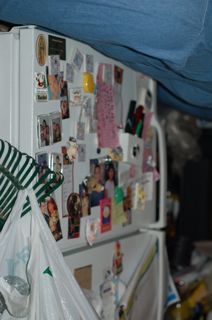
The refrigerator is the clue that something is exceptionally wrong. You would think it was purchased at the local Best Buy store and placed in a suburban home, with its spattering of magnets securing family snapshots.
Sarah points out the photos like they are digital trophies of a life lost years ago. Some of the images depict two deceased sons. Others are of beloved family friends. At more than 60 years old, Sarah appears to be a grieving widow. Not too shocking for a person leaning toward the last phase of a long life.
It is the location of the refrigerator, however, that reflects her abysmal life situation. We are standing in a small Public Storage unit in a rough Los Angeles neighborhood.
Sarah is homeless, but manages to use her disability check to rent a tiny space that is supposed to be used for storage for middle-class excess. Instead, it has become a hideaway from the unsafe streets of America's second largest city.
As an executive of a homeless and housing agency, I have often heard the tales of homeless people living in Public Storage units. But no one on the streets was willing to reveal their secret hiding places to our street outreach teams.
Until now.
When you walk into Sarah's so-called home, you would think you are in some sort of messy college dormitory room, with its comfortable sitting chair, side table, television, and microwave. And, of course, the full standing refrigerator. She uses an air mattress for her bed.
Her storage space is tucked away in the middle of hundreds of other units inside of a large warehouse. There are bare light bulbs shining weak light, exposed wood trusses, and electricity. She rolls down the metal garage door and latches it from the inside for safety.
Sarah has been dodging Public Storage managers, out of fear of being discovered, for two years now. She tells me the exact shift schedules of each manager since those are the times she has to scuttle inside of her hidden unit, as if she is some sort of mouse not wanting to be caught by the big old cat.
Two years, and Sarah is tired of this existence. Sure, storage living is better than being exposed on the violent streets of Los Angeles. A woman like her would probably vanish quickly in the vicious world of street homelessness.
But a woman who has raised a family, and should be enjoying playing with grandchildren, should not be scurrying into a Public Storage unit for fear of being caught.
Decades ago, homeless people turned to shelters and transitional housing. Today, the options are limited. People are living in their vehicles, setting up tents, or sneaking into storage units.
The cost of building affordable apartments is high, even in this depressed real estate market. It will take years and billions of dollars to build enough housing for the hundreds of thousands of people living on the streets of America.
So why not build some sort of hybrid between a market rate apartment and a Public Storage unit? We need creative low-cost dignified housing so homeless people do not have to scamper into secret hiding places.
On the day I met Sarah, it was raining outside. She felt safe and warm in her storage bin. But she was ready to come out of her homeless closet and move into an apartment. The outreach team I was with began the plans to find her permanent housing.
Sarah was certainly ready to set up her refrigerator in an apartment kitchen, like most people do.
